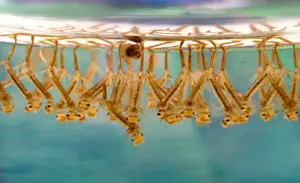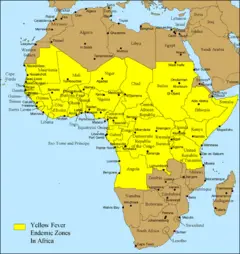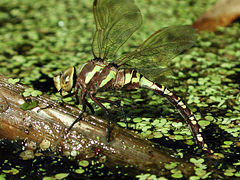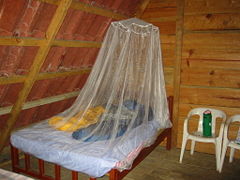Mosquito
| Mosquitoes | ||||||||||||||
|---|---|---|---|---|---|---|---|---|---|---|---|---|---|---|
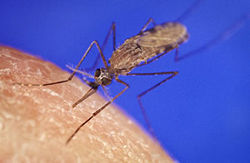 Anopheles gambiae
| ||||||||||||||
|
Conservation status: Secure
| ||||||||||||||
| Scientific classification | ||||||||||||||
| ||||||||||||||
|
Mosquito is a common term for any member of the insect family Culicidae of the order Diptera ("true flies"). Also known colloquially as "mozzies," "mossies," and "skeeters," mosquitoes are characterized by a pair of scaled wings, a slender and elongated body, long legs, and a long proboscis. They undergo complete metamorphosis (holometabolism), proceeding through an egg, larval, and pupal stage prior to becoming an adult that is markedly different from the larva. Eggs are deposited near or in water.
Female mosquitoes are particularly reviled for their annoying bites and as vectors of devastating diseases. The relatively short-lived males feed mainly on nectar and other plant juices. Female mosquitoes also utilize nectar as their main energy source, but almost all species require a blood meal to mature their eggs for reproduction. One of those sources is humans and their pet animals, as well as other vertebrates. Female mosquitoes that require or use human blood may also transmit protozoans, bacteria, and viruses and thus are major vectors of disease.
Malaria is caused by a protozoan of the genus Plasmodium that utilizes some species of the mosquito genus Anopheles in transmission. Mosquitoes of the genus Aedes (in Africa) and Haemagogus and Sabethes (in South America) transmit the virus that causes yellow fever. Aedes aegypti also transmits dengue to humans. Heartworm is a parasitic roundworm that is spread by mosquitoes to dogs, cats, wolves, sea lions, and even humans, among others. Some Culex species are vectors of filariasis, elephantiasis, and human encephalitis.
Only some species of mosquitoes are vectors of disease; many are host-specific and that host does not include humans, or they do not carry the parasitic agent. Furthermore, neither male mosquitoes nor larvae are a problem. For these, the vast number of mosquitoes, the value to the ecosystem is obvious, as they are a major prey item in food chains, being consumed by fish, birds, bats, and other animals, including insects. Even female mosquitoes that utilize human blood are less of a problem in healthy ecosystems (such as aquatic systems that have ample amounts of fish that consume the larvae) and hygiene environments (such as a lack of pools of stagnant water, which serve as a breeding ground). Defensive measures for protecting against the discomfort and health threat of mosquitoes include vaccines, insect repellents, and mosquito nets. The problem of disease also touches on societal responsibilityâindividuals with means have an obligation to help those without the means to obtain protective measures.
The family Culicidae contains about 3500 species in around 40 genera (depending on the scheme) placed in three subfamilies: Anophelinae (3 genera), the Culicinae (most genera and more than 80 percent of all the species), and the Toxorhynchitinae (1 genus). They are found in terrestrial locations in most parts of the world, including north of the Artic Circle.
Overview
As dipterans (true flies), mosquitoes are characterized by having a single pair of true wings, which are used for flight, while the hind wings are reduced into a pair of small knob-like structures called the halteres. Mosquitoes have characteristic scaled wing venation and, as noted above, females are known for their long proboscis.
Size varies, but is rarely greater than 15 mm (0.6 inch). Mosquitoes weigh only about 2 to 2.5 mg (0.03 to 0.04 grain). A single flight can last about 4 to 5 minutes. They can fly at about 1.5 to 2.5 km/h (0.9 to 1.6 mph) and most species are nocturnal or crepuscular, and are generally inactive during the day (Crans 1989).
Although males and females use plant juices as main energy sources, almost all female mosquitoes typically require a meal of blood for egg production. However, females of the genus Toxorhynchites are not known to drink blood and instead require only plant nectars for egg develoment (Jones and Schreiber 1994). Some of the 71 known species of this genus do not even need nectar, but protein used in reproduction apparently is derived from the feeding of the carnivorous larvae. (Jones and Schreiber 1994) These larvae, known as "mosquito eaters" and "mosquito hawks" are predatory on the larvae of other mosquitoes and thus are useful in biological control of mosquitoes (Joens and Schreiber 1994).
Because mosquito bites can transmit diseases, authorities in many areas take measures to reduce mosquito populations through pesticides or more organic means. An easy way to reduce mosquito populations in a residential area is the removal of standing water (where mosquitoes breed), and an effective preventive measure is the use of repellents, such as DEET.
Mosquitoes are believed to have evolved around 170 million years ago during the Jurassic era (206â135 million years ago) with the earliest known fossils from the Cretaceous era (144â65 million years ago). Krzywinski and Besansky (2002) state that phylogenetic evidence suggests the Anopheles mosquitoes originated in South America, spread throughout the Laurasia supercontinent, and and re-entered the tropics from the north.
Life cycle and feeding habits
In most female mosquitoes, the mouth parts form a long proboscis for piercing the skin of mammals (or in some cases birds, and even reptiles and amphibians) to suck their blood. The females require protein for egg development and laying, and since the normal mosquito diet consists of nectar and fruit juice, which has no protein, most must drink blood. Males differ from females, with mouth parts not suitable for blood-sucking.
The mosquito undergoes complete metamorphosis, going through four distinct stages in its life cycle: Egg, larva, pupa, and adultâa process that was first described by the Greek philosopher Aristotle. The length of the first three stages is dependent on the species and temperature. Culex tarsalis may complete its life cycle in 14 days at 20°C (68°F) and only ten days at 25°C (77°F). Some species have a life cycle of as little as four days, whereas in other species some adult females can live through the winter, laying their eggs in the spring. Many species of mosquito live their adult stage in roughly two weeks to two months.
The larvae are the "wrigglers" or "tumblers" found in puddles or water-filled containers. These breathe air through a siphon at the tail end. The pupae are nearly as active as the larvae, but breathe through thoracic "horns" attached to the thoracic spiracles. Most larvae feed on microorganisms, but a few are predatory on other mosquito larvae. Some mosquito larvae, such as those of Wyeomyia live in unusual situations. These mosquito wigglers live either in the water collected in epiphytic bromeliads or inside water stored in carnivorous pitcher plants. Larvae of the genus Deinocerites live in crab holes along the edge of the ocean.
Most mosquito species outside of the tropics overwinter as eggs, but a significant minority overwinter as larvae or adults. Mosquitoes of the genus Culex (a vector for St. Louis encephalitis) overwinter as mated adult females.
The females of blood sucking species locate their victims primarily through scent. They are extremely sensitive to the carbon dioxide in exhaled breath and exuded through the pores, as well as several substances found in sweat. Mosquitoes can detect heat, so they can find warm-blooded mammals and birds very easily once they get close enough.
Some people seem to attract mosquitoes more than others. Empirical studies of mosquito bites suggest that the risk of being bitten follows an approximately negative binomial distribution. Being male, being overweight, and having blood type O may increase the risk of being bitten. Vince (2006) reports that while everyone produces a mixture of odorous chemicals in their sweat and that some of these attract biting insects, some individuals produce, in greater amounts than other people, chemicals that appear to mask the scent of the attractive substances.
Mosquitoes and humans
Mosquitoes and health
In much of the world, mosquitoes are a major public health problem; they are estimated to transmit disease to more than 69 million people annually. In the United States, Australia, New Zealand, the UK, Scandinavia, and other temperate countries, mosquito bites are mostly just a nuisance (Fradin 1998).
The mosquito genus Anopheles carries the malaria parasite (Plasmodium). Worldwide, malaria is a leading cause of premature mortality, particularly in children under the age of five, with around 5.3 million deaths annually, according to the Center for Disease Control. Most species of mosquito can carry the filariasis worm, a parasite that causes a disfiguring condition (often referred to as elephantiasis) characterized by a great swelling of several parts of the body; worldwide, around 40 million people are living with a filariasis disability. Most species of mosquito can carry the viral diseases yellow fever, dengue fever, epidemic polyarthritis, Rift Valley fever, Ross River Fever, and West Nile virus. West Nile virus was accidentally introduced into the United States in 1999 and by 2003 had spread to almost every state. Fortunately, mosquitoes do not transmit HIV. Viruses carried by arthropods such as mosquitoes or ticks are known collectively as arboviruses.
A mosquito's period of feeding is often undetected; the bite only becomes apparent because of the immune reaction it provokes. As opposed to a syringe's typically smooth needle, a mosquito proboscis is highly serrated, which leaves a minimal number of points of contact with the skin being pierced. This reduces nerve stimulation to the point where the "bite" is not felt as strongly, if at all.
When a mosquito bites a human, she injects saliva and anti-coagulants. For any given individual, with the initial bite there is no reaction, but with subsequent bites the body's immune system develops antibodies and a bite becomes inflamed and itchy within 24 hours. This is the usual reaction in young children. With more bites, the sensitivity of the human immune system increases, and an itchy red hive appears in minutes where the immune response has broken capillary blood vessels and fluid has collected under the skin. This type of reaction is common in older children and adults. The red ringed white bump may be about a centimeter in diameter. This bump can itch for days and over-scratching the bite can cause it to bleed. Continued over-scratching can cause scars.
Some adults can become desensitized to mosquitoes and have little or no reaction to their bites, while others can become hyper-sensitive with bites causing blistering, bruising, and large inflammatory reactions.
Mosquitoes in flight emit a distinctive high-pitched buzz, which can interrupt sleep.
Mosquito control and integrated mosquito management
There are two kinds of mosquito control: Large, organized programs to reduce mosquito populations over a wide area, and actions individuals can take to control mosquitoes with respect to themselves and their own property.
Organized mosquito control programs today draw on the principles of integrated pest management. An integrated mosquito control program typically includes the following measures, all guided by surveillance of mosquito populations and knowledge of the mosquito life cycle (UF/AMCA 2007):
- source reductionâthe removal of mosquito breeding habitats
- habitat modificationâmanipulating habitats to reduce breeding
- biocontrolâintroducing natural predators of mosquitoes
- larvicideâusing pesticides to reduce larval populations
- adulticideâusing pesticides to reduce adult populations
The most effective solutions for malaria control efforts in the third world are: Mosquito nets, mosquito nets treated with insecticide (often permethrin), and DDT (NCID 2006). Nets are treated with insecticide because mosquitoes can sometimes get past an imperfect net. Insecticide-treated nets (ITN) are estimated to be twice as effective as untreated nets in preventing mosquito bites (Hull 2006). Untreated mosquito nets are less expensive, and they are effective in protecting humans when the nets do not have any holes and are tightly sealed around the edges. Insecticide free nets do not adversely affect the health of natural predators such as dragonflies.
The role of DDT in combating mosquitoes has been the subject of considerable controversy. While some argue that DDT deeply damages biodiversity, others argue that DDT is the most effective weapon in combating mosquitoes and hence malaria. While some of this disagreement is based on differences in the extent to which disease control is valued as opposed to the value of biodiversity, there is also genuine disagreement among experts about the costs and benefits of using DDT. Moreover, DDT-resistant mosquitoes have started to increase in numbers, especially in tropics due to mutations, reducing the effectiveness of this chemical.
Mosquito repellents and personal mosquito control
Mosquito repellents generally contain one of the following active ingredients: DEET (Meta-N,N-diethyl toluamide), catnip oil extract, nepetalactone, citronella, or eucalyptus oil extract. Often the best "repellent" is a fan or gentle breeze as mosquitoes do not like moving air. Otherwise, DEET is a highly effective repellent against mosquitoes, especially when worn in conjunction with light colored clothing and a hat to cover the head. Higher concentrations allow for longer intervals between applications, but some health concerns persist over the use of pure DEET oil. At the very least, it will damage certain plastics, so care must be used when applying.
Other popular methods of household mosquito control include use of small electrical mats, mosquito repellent vapor, and mosquito coil, all containing a form of the chemical allethrin. Mosquito repellent candles containing Citronella oil is another method to keep mosquitoes at bay. Some lesser known methods use the cultivation of plants like wormwood or sagewort, lemon balm, lemon grass, lemon thyme, and the mosquito plant (Pelargonium). However, scientists have determined that these plants are effective only when the leaves are crushed and used and applied directly to the skin.
There are several widespread theories about mosquito control such as the assertion that Vitamin B (in particular thiamine), garlic, ultrasonic devices, incense, bats, purple martins (type of bird), and bug zappers can be used to repel or control mosquitoes. Whether these methods are effective at deterring mosquitoes or significantly reducing mosquito populations remains disputed. Moreover, complaints have been made that some claims of effectiveness by manufacturers of "mosquito repelling" ultrasonic devices are false (Federal Trade Commission 2002). Although bats can be prodigious consumers of insects, many of which are pests, less than 1 percent of a bat's diet will consist of mosquitoes; bats mostly feed on larger insects such as beetles. Bats are known carriers of rabies, so care must be taken if attempting to use bats to control insects. Similarly, bug zappers kill a wide range of flying insects including many beneficial insects as well as mosquitoes; bug zappers are not effective at controlling mosquito populations.
Some newer mosquito traps emit a plume of carbon dioxide together with other mosquito attractants such as sugary scents, lactic acid, octenol, warmth, water vapor, and sounds. By mimicking a mammal, these factors draw female mosquitoes toward the trap, where they are typically sucked into a net or holder where they collect. According to the American Mosquito Control Association (2005), "these devices will, indeed, trap and kill measurable numbers of mosquitoes," but their effectiveness in any particular case will depend on a number of factors, such as the size and species of the mosquito population and the type and location of the breeding habitat. The relative effectiveness of these newer mosquito traps is still being studied.
Treatment of mosquito bites
Visible, irritating bites are due to an immune reaction, i.e., hypersensitivity (undesirable reactions produced by the normal immune system). This hypersensitivity is a reaction of IgG and IgE antibodies to antigens in the mosquito's saliva. Some of the sensitizing antigens are common to all mosquito species, whereas others are specific to certain species. There are both immediate hypersensitivity reactions (Type I, immediate or atopic or anaphylactic and Type III, immune complex) and delayed hypersensitivity reactions (Type IV, cell-mediated or delayed) to mosquito bites (Clements 2000).
There are several commercially available remedies. A common treatment is direct application of calamine lotion, which may have a soothing effect, although its effectiveness is not medically proven. Other insect bite relief sticks are commercially available. Oral or topically applied antihistamines, and diphenhydramine (Benadryl ointment) in particular, seem to be particularly good at relieving the itch. Topical corticosteroids such as hydrocortisone and triamcinolone can help with more severe or inopportunely placed bites. Other treatments include application of toothpaste, oil of Melaleuca Alternafolia plant, heat, toothpaste, or Mylanta or another liquid antacid.
Cultural views
Olivia Judson, an evolutionary biologist, advocates the deliberate extinction of 30 mosquito species through the introduction of recessive "knockout genes" (Judson 2003). She bases this controversial view on the following reasoning:
- Anopheles mosquitoes and the Aedes mosquito represent only 30 species; eradicating these would save at least one million human lives per annum at a cost of reducing the genetic diversity of the family Culicidae by only 1 percent.
- Since species go extinct "all the time," the disappearance of a few more will not destroy the ecosystem: "We're not left with a wasteland every time a species vanishes."
- Removing one species sometimes causes shifts in the populations of other speciesâ"but different need not mean worse."
- Anti-malarial and mosquito control programs offer little realistic hope to the 300 million people in developing nations who will be infected with acute illnesses in a given year; although trials are ongoing, she writes that if they fail: "We should consider the ultimate swatting."
ReferencesISBN links support NWE through referral fees
- American Mosquito Control Association (AMCA). 2005. Traps. American Mosquito Control Association. Retrieved March 4, 2007.
- Clements, A. N. 2000. The Biology of Mosquitoes. Volume 1: Development, Nutrition and Reproduction. Oxon: CABI Publishing. ISBN 0851993745
- Crans, W. J. 1989. Resting boxes as mosquito surveillance tools. Proceedings of the Eighty-Second Annual Meeting of the New Jersey Mosquito Control Association, pp. 53-57. Retrieved March 3, 2007.
- Davidson, E. (ed.) 1981. Pathogenesis of Invertebrate Micorobial Diseases. Totowa, NJ: Allanheld, Osmun & Co. Publishers.
- Federal Trade Commission. 2002. FTC alleges electronic mosquito repellent claims are false; Sellers also lack evidence for ultrasonic pest-control and air cleaning product claims. Federal Trade Commission. Retrieved March 4, 2007.
- Fradin, M. S. 1998. Mosquitoes and mosquito repellents: A clinician's guide. Annals of Internal Medicine 128: 931-940. Retrieved July 10, 2006.
- Hearn, L. 1968. Kwaidan: Stories and Studies of Strange Things. Dover Publications, Inc. Originally published, 1904. ISBN 0486219011
- Hull, K. 2006. Malaria: Fever wars. Public Broadcasting System documentary. Retrieved March 3, 2007.
- Jahn, G. C., D. W. Hall, and S. G. Zam. 1986. A comparison of the life cycles of two Amblyospora (Microspora: Amblyosporidae) in the mosquitoes Culex salinarius and Culex tarsalis Coquillett. J. Florida Anti-Mosquito Assoc. 57: 24â27.
- Jones, C., and E. Schreiber. 1994. The carnivores, Toxorhynchites. Wing Beats 5(4):4.
- Judson, O. 2003. A bug's death. New York Times September 25, 2003.
- Kale, H. W. 1968. The relationship of purple martins to mosquito control. The Auk 85: 654-661.
- Krzywinski, J., and N. J. Besansky. 2002. Bloodthirsty hitchhikers? Science 295:973. Retrieved March 3, 2007.
- National Center for Infectious Diseases (NCID), Division of Parasitic Diseases. 2006. Malaria: Vector control. Centers for Disease Control. Retrieved March 4, 2007.
- University of Florida and American Mosquito Control Association (UF/AMCA). 2007. Chapter 3: Mosquitoes. In Public Health Pest Control's Public Health Pesticide Applicator Training Manual. Retrieved March 4, 2007.
- Vince, G. 2006. Revealed: What mosquitoes hate about humans. NewScientist.com. Retrieved March 4, 2007.
Credits
New World Encyclopedia writers and editors rewrote and completed the Wikipedia article in accordance with New World Encyclopedia standards. This article abides by terms of the Creative Commons CC-by-sa 3.0 License (CC-by-sa), which may be used and disseminated with proper attribution. Credit is due under the terms of this license that can reference both the New World Encyclopedia contributors and the selfless volunteer contributors of the Wikimedia Foundation. To cite this article click here for a list of acceptable citing formats.The history of earlier contributions by wikipedians is accessible to researchers here:
The history of this article since it was imported to New World Encyclopedia:
Note: Some restrictions may apply to use of individual images which are separately licensed.
